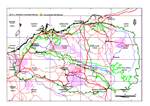Click on images
to enlarge



Photographer: B.R. Maslin

Photographer: B.R. Maslin
, habit, BRM 8805_sml.jpg)
Airlie Island. Photographer: B.R. Maslin
, flowers pods, BRM 8896_sml.jpg)
Airlie Island. Photographer: B.R. Maslin
Botanical name
Acacia bivenosa x sclerosperma subsp. sclerosperma
Description
Bushy or sometimes openly branched, spreading shrubs 1-3 m tall and 2-4 m across. Bark smooth, grey. Branchlets glabrous or rarely with fine, short, straight, patent hairs. Phyllodes narrowly oblong-oblanceolate to narrowly oblong-elliptic, narrowed at base, (4-) 5-9 cm long, 4-10 (-15) mm wide, ascending to erect, coriaceous to ±fleshy when fresh, very finely longitudinally wrinkled when dry, glabrous or rarely hairy on upper margin near the base (hairs as on branchlets), pale green to sub-glaucous; with a ±prominent midrib, sometimes (on broadest phyllodes) a second less prominent nerve parallel to the midrib; apex mucronulate, the mucro central or more commonly excentric. Gland situated on upper margin 6-15 mm above the pulvinus, a smaller gland often present at base of the minute apical mucro or up to 3 mm below it. Inflorescences racemose, the raceme axis 3-30 mm long and often becoming growing out at the apex with the single peduncles within the axil of young phyllodes; peduncles 10-22 mm long, glabrous; heads globular, 15-25-flowered, golden. Flowers 5-merous; calyx truncate to sinuate-toothed. Pods sub-moniliform, readily breaking into 1-seeded segments at the constrictions between seeds, length unknown, 7-11 mm wide, woody, glabrous. Seeds not seen but recorded by one collector as being brown, it is assumed that the aril would be red in colour.
Characteristic features
Spreading shrubs. Branchlets glabrous, rarely finely hairy. Phyllodes narrowly oblong-oblanceolate to narrowly oblong-elliptic, mostly 5-9 cm long and 4-10 mm wide, narrowed at base, very finely longitudinally wrinkled when dry, normally glabrous; midrib ±prominent, sometimes with a second less prominent nerve parallel to the midrib. Gland 6-15 mm above the pulvinus, a smaller gland often present near apical mucro. Inflorescences short-racemose, the racemes 3-30 mm long and often growing out at apex; peduncles glabrous; heads globular, golden. Pods sub-moniliform, readily breaking into 1-seeded segments at the constrictions between seeds, broad, woody.
Distribution and ecology
Mainly confined to the Pilbara region of northwest Western Australia where it is where most collections are from the Dampier - Karratha area, however, it also found near Millstream and east of Newman; an outlier population is found just outside the southern boundary of the Pilbara, in the Barlee Range Nature Reserve (about 150 km west of Paraburdoo); also occurs on Airlie and Thevenard Islands, off Onslow (see under Taxonomy for discussion). Field studies and pods are needed to check the identity of flowering collections from near Wickham, Port Hedland and Paraburdoo that are provisionally referred to this hybrid; these gatherings have a superficial resemblance to A. ligulata which apparently is extremely rare in the Pilbara.
Flowering and fruiting period
Flowers from late June to early August.
Variation
Phyllode width and nerve number variable.
Taxonomy
The hybrid status of the entity described here as A. bivenosa x sclerosperma subsp. sclerosperma has been determined on the basis of field observations and morphological criteria. In a number of areas these plants have been observed (at low frequencies) in populations containing the two parents.
Plant from Airlie and Thevenard Islands that were referred to by Chapman and Maslin (1992) as an elongate phyllode variant of A. bivenosa and which are currently listed at the W.A. Herbarium as Acacia sp. Airlie Island (V. Long VL 163) are also likely to be A. bivenosa x sclerosperma subsp. sclerosperma hybrids); typical A. bivenosa occurs on Airlie Island, but is not recorded from Thevenard Island, while typical A. sclerosperma subsp. sclerosperma occurs on both islands but is apparently rare (see Maslin 2007 for discussion).
Affinities
The phyllodes of A. bivenosa x sclerosperma subsp. sclerosperma may sometimes superficially resemble those of A. ampliceps x bivenosa hybrids (these two hybrids grow close to one another in some areas, e.g. around Karratha) but the former is distinguished by its golden (not lemon yellow) heads, broader pods and the lowermost gland on the phyllodes being further removed from the pulvinus. Acacia bivenosa x sclerosperma subsp. sclerosperma is sometimes sympatric with A. ampliceps x sclerosperma (e.g. around Karratha and Millstream) but the former is recognized by its golden (not lemon yellow) heads and generally broader and shorter phyllodes.
Conservation status
Not considered rare or endangered.
